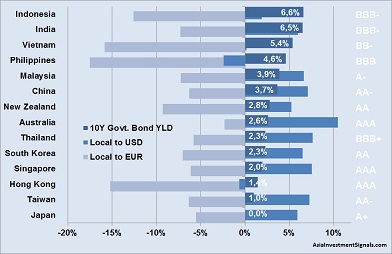 ‘There is time to go long, time to go short, and time to go fishing.’ said once Jesse Livermore, an American investor and security analyst in the early 20th century.
‘There is time to go long, time to go short, and time to go fishing.’ said once Jesse Livermore, an American investor and security analyst in the early 20th century.
But where to park your money safely in Asia when not invested in the stock market?[mepr-active membership=”1734″ ifallowed=”show” unauth=”message” unauth_message=”Please login or purchase a membership to view full text.”] The graph shows the latest yields of 10-year government bonds (dark blue) in the Asia Pacific region. On the right side of the chart, the Standard & Poor country rating indicates the long-term foreign currency credit ratings for sovereign bonds. According to S&P, a bond is considered investment grade if its credit rating is BBB- or higher. Ratings of BB+ and below are considered to be speculative or junk grade.
The graph shows the increase and decrease of each local currency against the US Dollar (middle blue) and the Euro (light blue) furthermore.
10-year government bonds currently yield the highest in Indonesia with 6.6%, followed by India (6.5%) and Vietnam (5.4%). The lowest yields offer currently government bonds in Japan (0%), followed by Taiwan (1%) and Hong Kong (1.4%).
How much return remains in the pocket of a foreign investor depends on the development of the currency. Most currencies in the Asia Pacific region have gained against the USD since the beginning of this year. The strongest increase against the USD experienced the Australian Dollar (AUD) with 10.5%, followed by the Thai Baht (THB) with 7.6% and the Singapore Dollar (SGD) with 7.5%. Only two local currencies have decreased against the USD, which was the Hong Kong Dollar (HKD) which lost 0.6% and the Philippines Pesos (PHP) which lost 2.4%.
On the other hand, all Asia Pacific currencies have lost against the EUR this year. The highest drop experienced the PHP with -17.5%, followed by the Vietnamese Dong (VND) with -15.9% and the HKD with -15.2%. To a lesser extent decreased the AUD with only -2.3%, followed by the Japanese Yen (JPY) with -5.5%, and the THB with -5.8%.
[/mepr-active]
